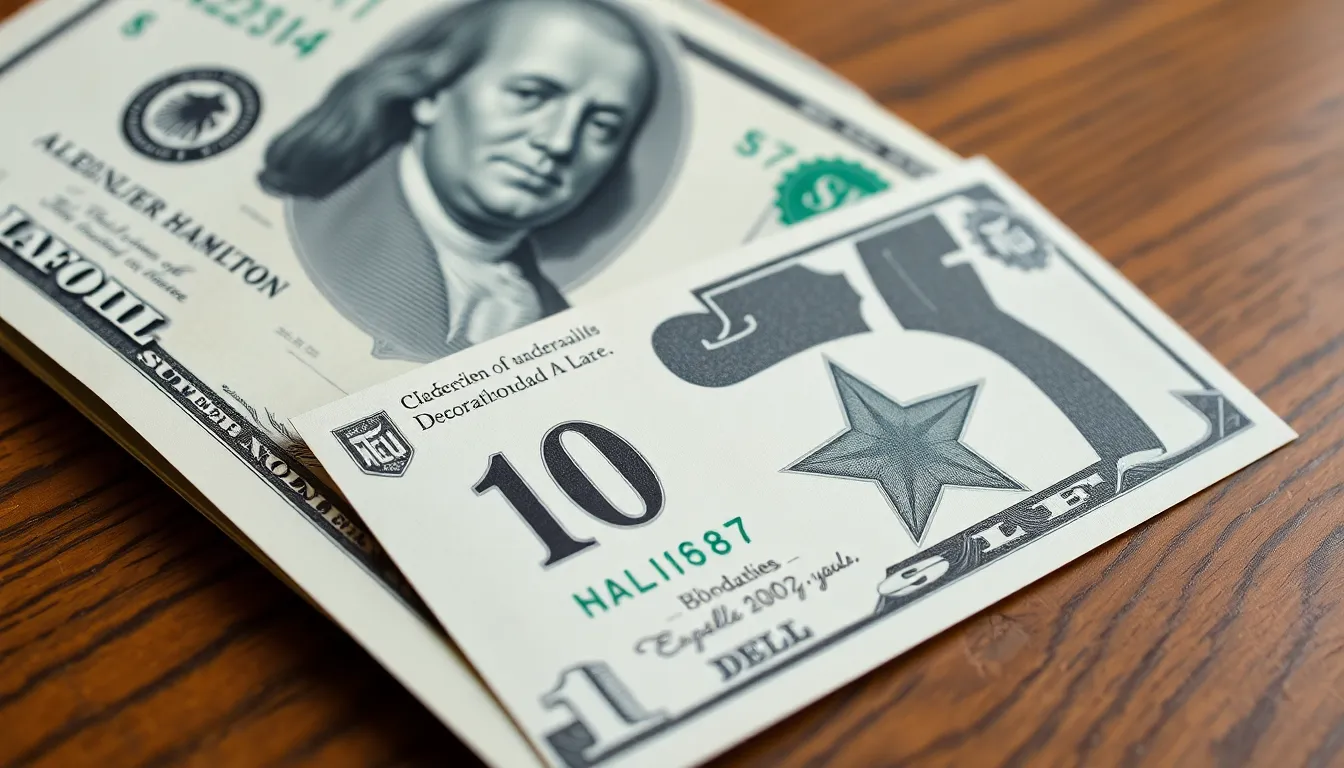The 1985 ten dollar bill holds a unique place in the hearts of collectors and currency enthusiasts alike. With its striking design featuring the portrait of Alexander Hamilton, this bill is not just a piece of paper; it’s a window into the past and a testament to changing monetary policies. As the years go by, the value of this bill can fluctuate based on various factors, making it an intriguing topic for both seasoned collectors and casual observers.
Understanding the value of a 1985 ten dollar bill involves more than just looking at its face value. Factors like its condition, rarity, and any unique printing errors can significantly impact its worth. Whether someone stumbles upon one in an old wallet or actively seeks it out, knowing its potential value can lead to surprising discoveries in the world of currency collecting.
Table of Contents
ToggleOverview of the 1985 10 Dollar Bill
The 1985 ten dollar bill features a portrait of Alexander Hamilton on the front, set against an intricate design that highlights key attributes of American currency. This bill forms part of the series known for its distinct colors and enhanced security features aimed at preventing counterfeiting.
Collectors find value in the bill, not just for its historical significance, but also for its features such as the Federal Reserve Bank seal and the serial number. These elements contribute to the overall appeal to both casual finders and dedicated collectors. The value of the 1985 ten dollar bill varies, primarily influenced by factors like condition, rarity, and presence of unique printing errors.
In pristine condition, uncirculated bills command higher prices, often reaching $30 or more in the collector’s market. Lower-grade bills tend to sell for face value or slightly above, depending on their rarity. Notably, specific printing errors, such as misalignments or ink discrepancies, can significantly increase the bill’s market value, occasionally drawing interest from collectors seeking rare specimens.
Overall, the 1985 ten dollar bill serves as a fascinating intersection of history and finance, appealing to those interested in American heritage.
Factors Affecting the 1985 10 Dollar Bill Value

Several factors play a crucial role in determining the value of the 1985 ten dollar bill. Understanding these elements can help collectors assess the worth of their bills accurately.
Condition and Grading
Condition greatly influences the value of the 1985 ten dollar bill. Grading standards classify currency based on its physical condition. Common grades include:
- Uncirculated: Bills showing no signs of handling, often commanding higher prices (around $30 or more).
- Fine: Bills with moderate wear, generally valued near face value to slightly above.
- Very Fine: Bills with minor folds and discoloration, typically selling for slightly more than face value.
- Good: Bills that exhibit significant wear, often valued at or just above face value.
Collectors often prioritize bills in pristine condition, as these carry a premium in the market. More thorough examinations can reveal subtle wear that affects grading and thus, value.
Star Notes and Rarities
Star notes significantly affect the value of the 1985 ten dollar bill. These notes feature a star symbol next to the serial number, identifying them as replacements for misprinted or damaged bills. Their limited supply often boosts desirability, making them more valuable than regular notes.
Additionally, rarity plays a vital role in valuation. Unique printing errors, such as misalignments or ink smudges, can create a substantial increase in value. Collectors actively seek these rare specimens, resulting in higher prices at auctions.
Both condition and rarity alongside features such as star notes impact the market value of the 1985 ten dollar bill. Understanding these factors assists collectors in determining the worth of their currency more accurately.
Market Demand for the 1985 10 Dollar Bill
Market demand for the 1985 ten dollar bill fluctuates based on various factors impacting collectors and investors. Increased interest in historical currency has heightened the attention on this specific denomination.
Collectors and Investors
Collectors and investors actively seek the 1985 ten dollar bill for its historical significance and design featuring Alexander Hamilton. High demand exists for uncirculated bills, often priced at $30 or more depending on condition and rarity. Enthusiasts particularly value star notes and those with unique printing errors. Regular participation in collector groups and online forums helps maintain interest, driving prices higher as scarcity increases. Investors view exceptional specimens as potential assets, leading to significant price appreciation over time.
Auction Prices and Sales Trends
Auction prices for the 1985 ten dollar bill demonstrate the variable market landscape. Recent sales reveal uncirculated bills fetching upwards of $50, while lower-grade bills tend to secure face value or a slight premium. Historical auction data indicates that unique printing errors can command premiums of 100% or more. Tracking sales trends aids collectors in understanding market fluctuations, enabling informed buying and selling decisions. Overall, continuous interest in the 1985 ten dollar bill highlights its status as a valuable collectible within the currency market.
Key Features of the 1985 10 Dollar Bill
The 1985 ten dollar bill features distinct characteristics that appeal to collectors and enthusiasts. Understanding its design elements and security features enhances appreciation of this collectible currency.
Design Elements
The 1985 ten dollar bill showcases a portrait of Alexander Hamilton on the front, symbolizing the nation’s historical monetary foundations. The bill’s background includes vibrant blue and green hues, with intricate patterns that add visual appeal. A notable feature is the depiction of the U.S. Treasury Building on the reverse side, which reflects American architectural heritage. The Federal Reserve Bank seal, unique serial numbers, and a “TEN” denomination prominently displayed contribute to its recognizable design. Collectors often prioritize bills with clear printing and minimal wear, as these traits signify higher quality.
Security Features
Enhanced security features were integral to the design of the 1985 ten dollar bill, aimed at preventing counterfeiting. Watermarks, microprinting, and security threads embedded within the bill serve to deter fraudulent reproduction. The paper’s distinct texture also plays a role in authenticating the currency. A colored numeral “10” on the front provides an additional layer of security, which shifts in appearance when viewed from different angles. Collectors pay attention to these security features, as bills with intact elements are generally valued higher in the market.
The 1985 ten dollar bill stands as a testament to American history and currency evolution. Its unique design and historical significance continue to attract both casual finders and dedicated collectors. The varying values based on condition and rarity highlight the bill’s appeal in the collector’s market.
As interest in historical currency grows, the demand for this particular bill remains strong. Collectors are drawn to pristine uncirculated notes and those with unique printing errors, driving prices higher. The 1985 ten dollar bill not only serves as a piece of currency but also as a collectible that reflects America’s rich monetary heritage.





